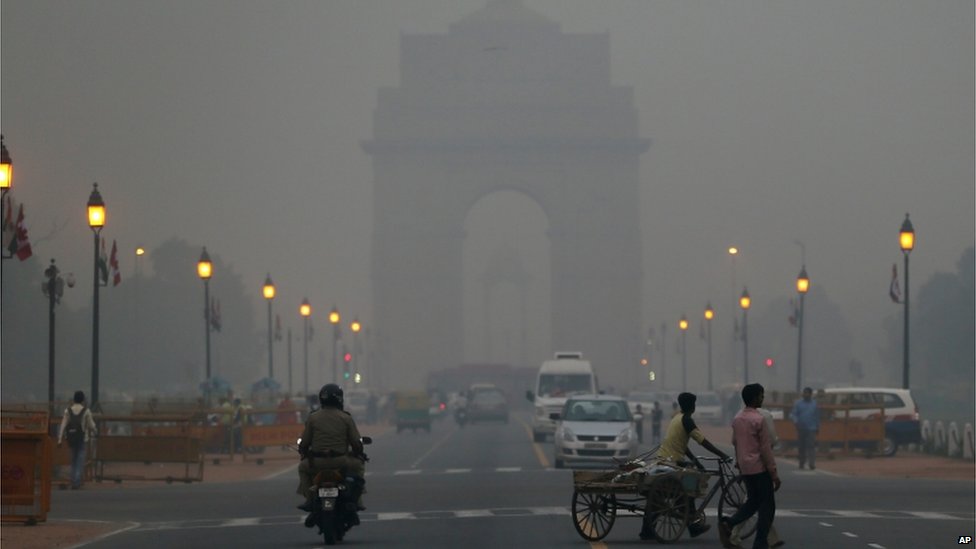Five Reasons Why Delhi Is The Most Polluted City In The World
Why is Delhi so polluted?

A study released by the World Health Organization (WHO) earlier this year showed that Delhi has the worst air quality in the world.
More than 1600 cities across 91 countries were surveyed and it was found that the capital city has the highest concentration of PM2.5 particles- particulate matters with less than 2.5 microns.
The concentration of PM2.5 particles is generally used to compare the pollution level in different areas. Delhi has a PM2.5 rating of 153 micrograms, which represents an “unhealthy air quality” that causes “increased respiratory effects in general population”.
A report by the Hindu has brought the issue of air pollution again into the limelight and here are five reasons for Delhi’s hazardous atmosphere.
Construction Dust and Emissions from Factories
Construction site dust typically comprises “small particles such as soot and cement and larger particles such as grit, sand and wood dust”. Construction activities like extension of the metro lines across South Delhi and building of residential areas in eastern and western parts of the city degrade the air quality.
In addition to this, factories in and on the outskirts of Delhirelease toxic chemicals that contaminate the air. A study by Jawaharlal Nehru University (JNU) in 2013 showed that industries and thermal power plants contribute to 29 percent of the total air pollution in Delhi. In the industrial area of Okhla, maximum amount of particulate matter (2,118.45 ìg/m3) was found.
“Nickel and cadmium have been found in Delhi's air…main source of these metals is industries…factories are not in abundance in Delhi, but they have emerged as a big source of health concern," said T.K. Joshi, director, Occupational and Environmental Program.
Vehicular Emissions
Vehicular emissions contribute to 63 percent of the air pollution in Delhi.
Burning of petrol and diesel to run automotive vehicles releases greenhouse gasses. Delhi is flooded with more than seven millions cars and 1400 new ones are added to this tally everyday.
Introduction of CNG-fuelled vehicles at the beginning of the century had “cleaned the city’s air”, but statistics show that Delhi’s pollution has increased five times over the past eight years.
Moreover, thousands of trucks that make way into the city late at night are responsible for 65 percent of the total particulate matter in Delhi’s air. Most of them enter the city unregulated, despite a Supreme Court order to keep them out of the capital.
Two more relating factors that cause air pollution are the fuel pumps and sale of adulterated fuel in Delhi.
The fuel pumps don’t have a Vapor Recovery System (VRS) that helps in limiting the release of pollutants into the air like in Western countries, while use of adulterated fuel increases emissions.
Deforestation and high Population Density
According to a research carried out by Indian Institute of Science (IIsc), Delhi lost 99,850 hectacres of forest between 2007 and 2009.
Couple this with the population boom Delhi has experienced recently, having become the second most populous city in the world after Tokyo, a respiration imbalance has occurred in the city.
Burning of Paddy Fields in Punjab and Haryana
Every year in the post monsoon season (October-November), more than 20 billion tonne of straw is set afire within a fortnight in Punjab and Haryana.
The burning of paddy residue fills the air with 12 megatonne of carbon-dioxide, which not only acts as a catalyst for global warming, but also causes the soil to lose its fertility, kills farmer friendly insects and destroys nitrogen content worth Rs 250 crore.
Despite a ban on paddy burning, farmers continue to practice this activity as an entire field can be reduced to ashes in ten minutes.
"Each year, the agriculture department spreads the same message highlighting the ill-effects of straw burning in the fields, but farmers rarely pay heed to it. Burning of straw causes severe harm to soil fertility and creates massive air pollution, inviting health problems," said Lakhwinder Hundal, chief agriculture officer in Gurdaspur.
Other Factors- Diwali, Geography, the Winter Season
Air pollution in Delhi worsens during the winter.
"Dust and soil level in the air increase in summer when temperatures are high with less rainfall. However, in winter season, when people use wood and other substances for heating, low temperature accompanied with little or no wind can lead to building-up of pollutants in the atmosphere," said Roy Harrison of Birmingham University.
Millions of citizens burning firecrackers on Diwali is yet another cause of air pollution. A day after Diwali this year, Delhi’s pollution level reached nine times higher than the normal level.
Geographically, Delhi also suffers from the atmospheric dust blown in from the deserts of the western state of Rajasthan and the polluted air that makes way from the industries and burning farms of neighboring states of Uttar Pradesh, Haryana and Punjab.
(Sources: The Hindu, Times of India, World Health Organization, India Today, Jawaharlal Nehru University, NDTV, Indian Institute of Science).


